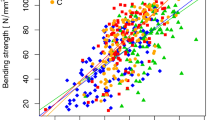Abstract
The strength of graded timber is determined by a multitude of parameters. Properties of interest are the shape of the cross-section and the wood quality. With regard to strength, wood quality is primarily expressed in terms of knots and knot clusters which, together with the cross-section of the timber, are used to calculate knot ratios. By applying the visual grading rules as given in the German standard DIN 4074-1, the influence of different timber sizes on grading results has been analysed. Different grading approaches for joists and boards exist and are taken into account in the assessment of 5,665 specimens originating from various parts of Europe. It was shown that both the cross-section and the grading method have a major influence on the characteristic strength values of Norway spruce. Limitations of the current standard with respect to its applicability to certain cross-sections are exposed. Alternative, simple grading approaches for boards are proposed. They ensure equal strength values and yields comparable to the rather complicated board rules used nowadays.
Zusammenfassung
Die Festigkeit von sortiertem Schnittholz kann durch mehrere Parameter beeinflusst werden. Querschnittsform und Holzqualität sind hierbei von besonderem Interesse. Im Zusammenhang mit der Festigkeit wird die Holzqualität vor allem über Äste und Astansammlung, die unter Berücksichtigung des Holzquerschnitts für die Berechnung von Kennzahlen verwendet werden, definiert. Die visuellen Sortierregeln der deutschen Norm DIN 4074-1 wurden angewandt, um den Einfluss des Holzquerschnitts auf das Sortierergebnis zu überprüfen. Unterschiedliche Sortierregeln für Kanthölzer und Bretter wurden beachtet, um 5,665 Prüfkörper aus Europa zu bewerten. Sowohl die gewählte Sortierregel als auch der Querschnitt haben einen wesentlichen Einfluss auf die charakteristischen Festigkeitswerte der Rotfichte. Es wird gezeigt, dass die aktuelle Norm bei gewissen Querschnitten nur eingeschränkt anwendbar ist. Alternative und gleichzeitig schlichtere Sortierregeln für Bretter werden vorgeschlagen. Diese gewährleisten gleiche Festigkeitswerte und ähnliche Ausbeuten im Vergleich zu den momentan verwendeten, komplizierteren Sortierregeln.










Similar content being viewed by others
References
Barrett JD, Lam F, Lau W (1992) Size effects in visually graded softwood structural lumber. CIB W 18 paper 25-6-5, Åhus, Sweden
Bohannon B (1966) Effect of size on bending strength of wood members. Forest Service Research Paper FPL 56, US Department of Agriculture, Washington, DC
Buchanan A (1990) Bending strength of lumber. J Struct Eng 116:1213–1229
Burger N, Glos P (1996) Einfluß der Holzabmessungen auf die Zugfestigkeit von Bauschnittholz. Holz Roh Werkst 54:333–340
Czmoch I, Thelandersson S, Larsen HJ (1991) Effect of within member variability on bending strength if structural timber. CIB W 18 paper 24-6-3, Oxford, United Kingdom
Denzler JK, Glos P (2008) Size effects in bending. CIB W 18 paper 41-6-4, St. Andrews, Canada
DIN 4074-1:1989-09 Sortierung von Nadelholz nach der Tragfähigkeit, Nadelschnittholz. DIN. Berlin
DIN 4074-1:2012-06 Sortierung von Holz nach der Tragfähigkeit, Nadelschnittholz. DIN. Berlin
EN 14080:2005 Timber structures—glued laminated timber—Requirements. CEN European Committee for Standardization, Brussels
EN 1912:2012 Structural timber—strength classes—assignment of visual grades and species. CEN European Committee for Standardization, Brussels
EN 338:2010 Structural timber—strength classes. CEN European Committee for Standardization, Brussels
EN 384:2010 Structural Timber—determination of characteristic values of mechanical properties and density. CEN European Committee for Standardization, Brussels
EN 408:2010 Timber structures—structural timber and glued laminated timber—determination of some physical and mechanical properties. CEN European Committee for Standardization, Brussels
Fewell AR, Curry WT (1983) Depth factor adjustments in the determination of characteristic bending stresses for visually stress-graded timber. Struct Eng 61B(2):35–40
Glos P, Richter C (2002) Sortierhilfen und Erläuterungen zur Anwendung der DIN 4074 in der Praxis. Bericht Nr. 02502, Holzforschung München, Technische Universität München. München, Germany, p 88
Glos P, Schleifer A, Linsenmann P (2002) Entwicklung vereinfachter Sortierregeln zur Festigkeitssortierung von Brettern und Bohlen. Bericht Nr. 01510, Holzforschung München, Technische Universität München. München, Germany, p 26
Madsen B (1992) Structural behaviour of timber. Timber Engineering Ltd Vancouver, Canada, p 405
Madsen B, Buchanan AH (1985) Size effects in timber explained by a modified weakest link theory. CIB W 18 paper 18-6-4, Beit Oren, Israel
Madsen B, Nielsen PC (1978) In-grade testing. Tension. Prepared for national lumber grades authority, Dept. of Civ. Eng., University of British Columbia, Vancouver, Canada
Øvrum A, Vestøl GI (2009) Modeling the effect of length on yield of sawn timber grades in Norway spruce [Picea abies (L.) Karst.]. Eur J Wood Prod 67:63–70. doi:10.1007/s00107-008-0286-9
Rouger F, Fewell AR (1994) Size effects in timber: novelty never ends. CIB W 18 paper 27-6-2, Sydney, Australia
Rouger F, De Lafond C, El Quadrani A (1993) Structural properties of French grown timber according to various grading methods. CIB W 18 paper 26-5-1, Athens, USA
Stapel P, van de Kuilen JW (2013) Efficiency of visual strength grading of timber with respect to origin, species, cross-section, and grading rules: a critical evaluation of the common standards. Holzforschung. doi:10.1515/hf-2013-0042
Author information
Authors and Affiliations
Corresponding author
Rights and permissions
About this article
Cite this article
Stapel, P., van de Kuilen, JW.G. Influence of cross-section and knot assessment on the strength of visually graded Norway spruce. Eur. J. Wood Prod. 72, 213–227 (2014). https://doi.org/10.1007/s00107-013-0771-7
Received:
Published:
Issue Date:
DOI: https://doi.org/10.1007/s00107-013-0771-7




